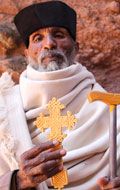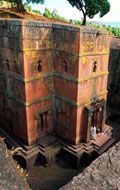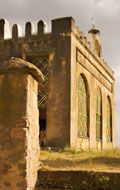Travel to the heartland of mother Africa – Ethiopia
Ethiopia is considered by many to be the most interesting and least known tour destination in Africa. For example, Ethiopia has more UNESCO World Heritage Sites than anywhere else in Africa - including Egypt. Ethiopia will definitely challenge everything you thought you already knew about Africa.
It’s where I grew up and spent my preteen childhood. I love the place and it still fascinates me more than half a century later. With my knowledge of Ethiopia from my many years spent there, fluency in the Amharic language and extensive network of friends and contacts, I can offer you a rare, intimate and unique travel experience in this beautiful and ancient land.
I'd like to share my great love of this wonderful country and I invite you to join me on an Ethiopian adventure.
Top Ethiopian travel destinations...

Addis Ababa – the capital of Ethiopia
Addis Ababa, is the 3rd highest capital in the world, at 2,355 m above sea level and home to over 3 million people. Founded in 1887 by Emperor Menelik, Addis Ababa is both diplomatic and nightclub central. Soak in the nightlife, unique cuisines and restaurants, Italian fascist architecture, friendly Ethiopian people, tradition and culture. Although Addis Ababa is considered a safe city, it is known for its petty crime and expert pick-pockets so care should be taken.
Lalibela – the city of rock churches
Lalibela, a little city of around 15,000 people is one of Ethiopia’s most holy cities in the Orthodox Christian tradition and the most significant destination for pilgrimages by Ethiopian Orthodox Christians from all over the nation. Lalibela is known for its 11 churches hewn from solid rock dating from the 12th century. These church buildings are architecturally ancient – the floors, columns, windows, doors and even the roofs were constructed by carving into deep layers and pieces of solid rock. Many scholars consider them built by King Lalibela as a safer pilgrimage destination after Muslim forces captured Jerusalem in 1187. Lalibela was Ethiopia’s capital from late 12th century to the 13th century.


Axum (or Aksum) – The religious capital of Ethiopia
The Axumite Empire was one of the greatest empires of its time. It became wealthy and powerful by controlling lucrative trade routes between the Roman Empire and ancient India from the 1st to 13th centuries CE. The ruins of the capital Axum, include the world’s largest obelisk or stelae carved from a single piece of granite in pre-Christian times. The largest is still standing and 21m high (70ft), but there were larger stelae, with the heaviest, now fallen and broken, estimated to have originally weighed in at around 500 tonnes. There are also many royal tombs. Ethiopians believe that the Ark of the Covenant is kept in a church in Axum, with access only granted to a single selected priest who may never leave that church. Queen Sheba, who reigned around 1000 BC, is reputed to have had Axum as her royal capital.
Simien National Park, magical mountains
The Simien National Park lies in the heart of the largest mountainous region in Africa – known as the Roof of Africa, with spectacular wide-ranging views over the rugged landscape. The park was listed by UNESCO in 1978 as the second-ever site of outstanding beauty. The Simien Mountains’ highest peak and Africa’s 10th tallest, is Ras Dashen at 4,550m. This region is home to some spectacular endemic mammal species – including the Gelada Baboon, the Walia Ibex, Caracal and the Simien Fox. There are over 180 bird species found within the national park – five of which are seen nowhere else. This includes large birds of prey such as the Lammergeier with it's spectacular 3 m wingspan..

Reasons to travel to Ethiopia
- Historic sites, structures and antiquities date back about 3,000 years and beyond.
- There is plenty of evidence that this is where the human species, Homo sapiens, originated and where our early hominid ancestors first walked upright.
- In Ethiopia you will experience people with a proud traditional culture, known for their hospitality to visitors. Their polite, respectful social customs are typified by the famous Ethiopian coffee ceremony.
- A huge range of wildlife, plant life and habitats with diverse terrain, exist in Ethiopia.
- Abundant birdlife with many endemic species in two areas we visit - the Simien Mountains and Awash National Park.
- Amazing cuisine. Yes, an irony as rich as a spicy Doro Wat. This is reflected by the large numbers of Ethiopian restaurants in countries where Ethiopians have settled.
- A never colonised contemporary culture including art, theatre and music with a unique contemporary sound known as Ethiopian Jazz.
- Ethiopia was voted World Best Tourist Destination 2015 by the General Assembly of the European Council on Tourism and Trade.
- Ethiopia’s internationally acclaimed Climate Resilient Green Economy vision is gathering pace. Feel the energy and optimism.
Lord of the Rings and its connection with Ethiopia
Some people even think J.R.R. Tolkien was inspired to write The Lord of the Rings trilogy by his probable knowledge of Ethiopia’s incredible history and geography. He never actually went to Ethiopia but he was born in South Africa in 1892 and would have had some knowledge of Africa.
Tolkien started writing the first book soon after Italy’s invasion of Ethiopia in 1935 which brought this mysterious mountainous kingdom with place names like Gondar, Roha, Harar Bahir Dar to world’s attention. These names are reminiscent of Gondor, Rohan, Harad and Barad-dur respectively. It’s an intriguing thought.






